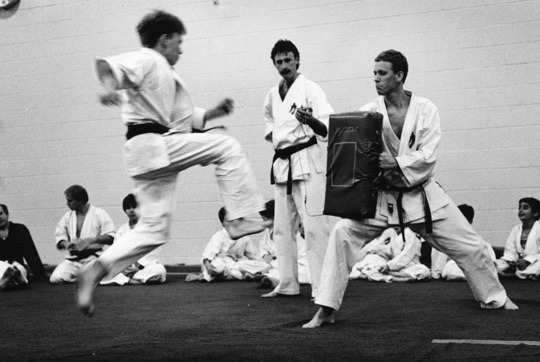
CHRONICLES OF THE DOKA
#37 in a continuing series
(84 days in the teaching life of an American sensei in 1999)
Sunday, January 16, (continued) Sunday, January 16
I drill the two teenage boys, Frankie and Chris, on slip-stepping and diagonal evasions. I tell Frankie to hold his hands atop his head, while Chris, the designated aggressor, must lightly punch strike torso. Frankie gets popped in the mouth by accident. His braces cut his lips—motivation to use his mouthpiece. This exercise is followed by lead change drills with multiple rounds on the heavy bag. The hour passes quickly.
I spot John K’s truck through the front window. John has driven an hour down from Greenwich, Connecticut for his private. He’s early. I see him lift his truck hood up. Something must be wrong with his vehicle. The man has poor carma!
The black belt, Iron Arms, affectionately calls John, ‘Grandfather.’
Most of the long-term black belt students get nicknamed over the years. John
has been a physical education teacher nearly as long as I have been a karate
sensei. Several years ago he was awarded ‘P.E.
Teacher of the Year’ through the Capherd organization.
John called me last week to tell me that he had misplaced the
karate curriculum we were working on. He wanted me to fax him a copy because he
was starting a self-defense program at Hamilton Ave. Elementary School in
Greenwich. I was unable to get him the fax on time so he improvised using the
general lesson plan gleaned from my book Smart
Moves, published a few years earlier through Simon and Schuster.
John comes to private karate classes for peace of mind, an
interest he shares with other students. Some private sessions never actually
get around to physical movement. Oftentimes, what is needed is more mental
movement; clarifications to remove life obstacles or to set the stage for
higher level understanding. As I explained in my book, The Soul Polisher’s Apprentice, life is like piecing together a
vertical puzzle. Only the pieces that fit at your current height of understanding make any sense. John opens the dialogue, “I ran the first unit, he says. “I opened
with questions, ‘Why self-defense. What is self defense?’ Then I moved to
stances, the pillars of strength.”
The horse stance is a universal posture found in every striking
art. Young children are usually first exposed to uncomplicated semi-aggressive
pushes or tugs. It’s natural for good teachers to start with simple concepts. “Then I showed them a basic wrist escape,” he added. “My reasoning
– if you get grabbed, not only will you want to stabilize yourself but you’ll
want to escape the grab.”
I like John’s logical sequencing of the material but I challenge him on some of the details. “95% of the time in my
classes,” I tell him, “whenever a child is grabbed and pulled, they can’t
escape from the grip if they go into a resistant posture first. The reason they
fail as the grabber pulls them, it lengthens their arm, making it less
effective to circle out. One of the strength principles in karate study is that
the further away your arm extends from your body, the weaker it becomes.” I ask
John, “If someone grabbed your right wrist and suddenly tugged you, how would
you go into horse stance with the best chance of resisting that tug? Would you
step back or forward and with which foot?”
He wasn’t sure.
“With quick enough reflexes you could step any way you wanted,” I
said “ but the ideal tactic would be
to step toward your opponent to
negate his pull. That is the best time to attempt your wrist escape. I break
single moves down into a logical, simple and sequential format before layering
two techniques together. Introduce the horse stance first. Follow with
resisting pushes and pulls. Introduce wrist escapes without any leg work at
some future date, then layer wrist escapes into your footwork.”
It’s not that children
cannot have fun or learn the two methods together. To create an ideal
foundation it is absolutely necessary to ground a student thoroughly into
their techniques. The stronger the base, the higher the future structure.
John and I also
discuss the need in physical education for the ‘fun’ element. If there isn’t an
element of fun in these lessons, most kids will loose interest today.
I have noticed a
disturbing teaching trend, whether it’s in a karate school, or in an
institutional academic classroom. Children are far more antsy and anxious.
Underlying their behavior in my opinion, is their doubt and confusion about
life. Life is complex and overwhelming for them. Life is moving much too fast
for young people to comprehend, no less find a deep taproot of meaningful
focus.
America is on a dumb down path. There is no one culprit to point a finger at. A
maddening social pace simply incurs a lot of meaningless movements.
